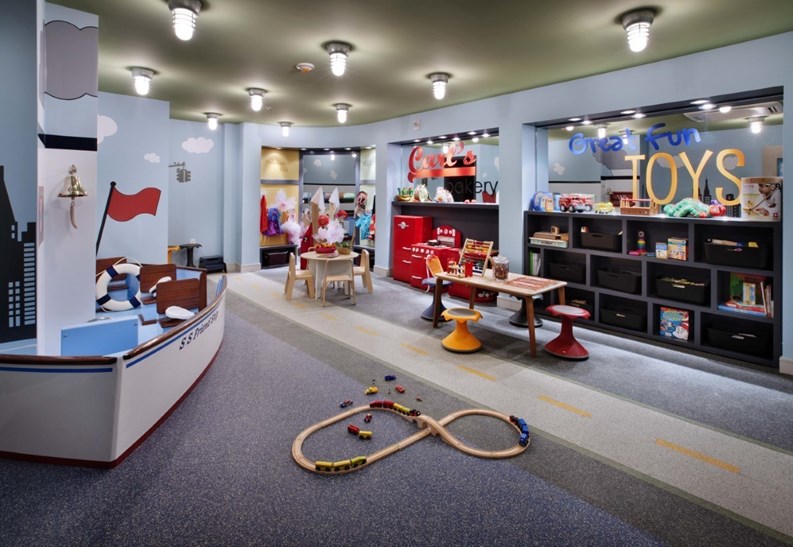What drives a prospective homeowner to purchase a condominium unit often depends on a host of variables. In this slowly rebounding economy, every dollar spent is scrutinized, and associated values must be transparent. For some, location is the paramount concern, while others might consider property taxes, a swimming pool or the performance of a respective school district. But before plunking down a significant investment, every buyer ponders the amenities offered: Laundry facilities, tennis courts, golf courses, an adjacent hiking trail or access to the city.
What buyers can expect with regard to building perks is often determined by location and price point. For example, in downtown Boston, a luxury condominium might offer hardwood floors, an in-unit washer/dryer, secure garage parking, a 24-hour doorman and a roof-deck terrace. At the same time, a reasonably priced suburban location in Connecticut may have community laundry facilities, include certain utilities, and be in walking distance to parks and transportation, or offer unassigned parking, onsite maintenance and shared recreational space.
“When it comes to what amenities a buyer wants, it is always different,” says Judy Moses, broker-owner of Pathway Home Realty Group. “It changes from region to region,” adds Moses, who works in the Newton and Brookline areas.
In most cases, buyers will forgo one amenity for another. “If a buyer is looking in the middle of the state, they might want open space and the different amenities that come with that,” says Moses. “For those who prefer the city, space is at a premium so the lifestyle of the city becomes the amenity.”
Whether new construction or an existing building, buyers are still in the driver’s seat when it comes to pulling the trigger and investing, but just like other real estate cycles, amenities that were once popular are not always a deal closer—what people want depends on region and demographic. For example, years ago pools were a significant selling point in many buildings but that has changed. “No one is ever in the pool when I am showing a listing,” says Moses. “Pools are not as popular a selling point as they once were,” she adds.
With any amenity, there is cost, and sometimes, as is the case with a pool, increased overhead in the form of maintenance, additional insurance and staffing. “The only amenity in any of my communities is a swimming pool,” says Steve Margolis, CMCA, AMS, president of the Hamden, Connecticut-based Margolis Management and Realty, LLC. “In one community it is somewhat of a nuisance because parents don’t keep a strict eye on their children, they want to bring food in to the pool area and sometimes unwanted guests arrive and crowd the pool,” he said. “Having a pool attendant is a hassle. More times than not, I don’t see the pool as a selling point.”
While the economy has been favorable in relation to lowering listing prices in certain areas, cash-strapped boards are slashing budgets whenever possible, which impacts not only what amenities are offered, but the operational condition. In many cases, seasonal outdoor amenities such as tennis courts can suffer from the freeze/thaw cycle, leading to cracks and bumps that require budgetary funds to properly maintain.
“The pools and tennis courts require additional maintenance and in many instances get overlooked or repairs deferred when it comes to upkeep,” says Margolis. “In a time where budgets are cut to the bone, these amenities are not getting the care and attention they deserve to make them an attractive part of the community.”
Downsizing Desires
Many prospective condominium owners are either baby boomers in the process of downsizing from a larger home, or young professionals/couples new to the market. Both these demographics, interestingly, look for similar amenities in city locations such as enhanced security, state-of-the-art technological features and on-site gyms.
“Many of these clients want to know if there is a media room and how the building is wired,” says Massachusetts Association of Realtors (MAR) President Trisha McCarthy, who has been in the real estate business since 1992. “They want to know if the building is supported by high-speed lines or FiOS. They want to know what the building offers.”
While McCarthy is broker at Keller Williams Realty in Newburyport, Massachusetts, she has her finger on the pulse of the entire real estate market looking for trends as well as fielding questions from curious buyers. “Across the state, we see more and more people downsizing from single family homes to condos,” she says. Those who are downsizing aren’t necessarily looking for pricing deals but location and perks. “Most of these buyers are only downsizing square footage because pricing is quite high for some of these units. We are seeing a decrease in the number of sales, but that could be a result of not as many condos being built or people are unable to sell their homes and can’t carry two mortgages,” she continues.
“What we are seeing is that people want more outdoor space, assigned parking/garages, and not so much amenities like pools,” says McCarthy. “People are asking for recreational space, bocce ball courts and dedicated space like a function room that can be rented out for family parties.”
For many buyers, square footage and available unit space are considered amenities. “It is very hard to find three bedrooms, two-bathroom units, but that is what many buyers look for,” says Moses. “Some also look for buildings with character, or old world charm, whereas others will look elsewhere if condo fees are too high and the services offered don’t seem agreeable to their needs.”
Weighing the Costs
As buyers enter the condominium market, some for the first time, they are confronted by monthly payments—some of which can creep towards a thousand dollars. When hit with this number, they want to know where this money goes, and weigh it against the amenities offered. “I would say that 70 to 80 percent of buyers will ask about the amenities and then consider what those amenities will mean to them,” says McCarthy. “There really is no ‘must have’ amenity for any one buyer; it all depends. I think people always look at location first.”
Positive market movement—which seemed to get a foothold in late 2011—is good news. With little new construction slated, existing amenities, along with the associated monthly fees, become critical, and building owners are paying attention. The problem for most, however, is that once a building is built with amenities it is hard to change them without significant overhead.
When asked if she has even experienced a building repurposing a major amenity such as an indoor pool, Moses says it is unheard of in the region. “I have never seen it done,” says Moses. “The problem with amenities like pools is that the condo fees are so high as a result and buyers will question whether they really need to have a pool in their building, and most don’t.”
In order to change a pool to, say, a great room, fitness center or recreational room, would require board approval, special permits, discretionary funds and the hassle of construction which disrupts the life of the residents. In most cases, Moses says a building is essentially stuck with an amenity once it is built.
If the decision was made to make an improvement or repurpose an amenity, it requires due diligence and planning. “Our objective is to assist community associations by helping them recognize that they must have a long-term capital plan in place. We help to identify what the major physical components of the plan should include, the items that need to be replaced, timetable and funding mechanics,” says Margolis. “We involve outside resources as necessary to provide consultation services and advise community leadership on sound building practices and cost-effective methods.”
Where older buildings can improve upon amenities is by adding a doorman or giving units a facelift, explains Moses. “Quality finishes in the kitchen and the bathroom go along way, too, because buyers can quickly tell if something is cheap,” says Moses. “Buildings that update their central air and heating systems also do better when it comes to sales.”
While it sounds logical for condominium developers to speak with realtors before including one amenity over another, McCarthy said that is rarely the case. “I don’t see that happening up here but I don’t think it is a bad idea,” she says. “Often times, what we see is developers meeting with the planning boards of the community; so they do their homework on a town and city level first to determine what amenity will work best in a specific location.”
W. B. King is a freelance writer and a frequent contributor to New England Condominium.






Leave a Comment